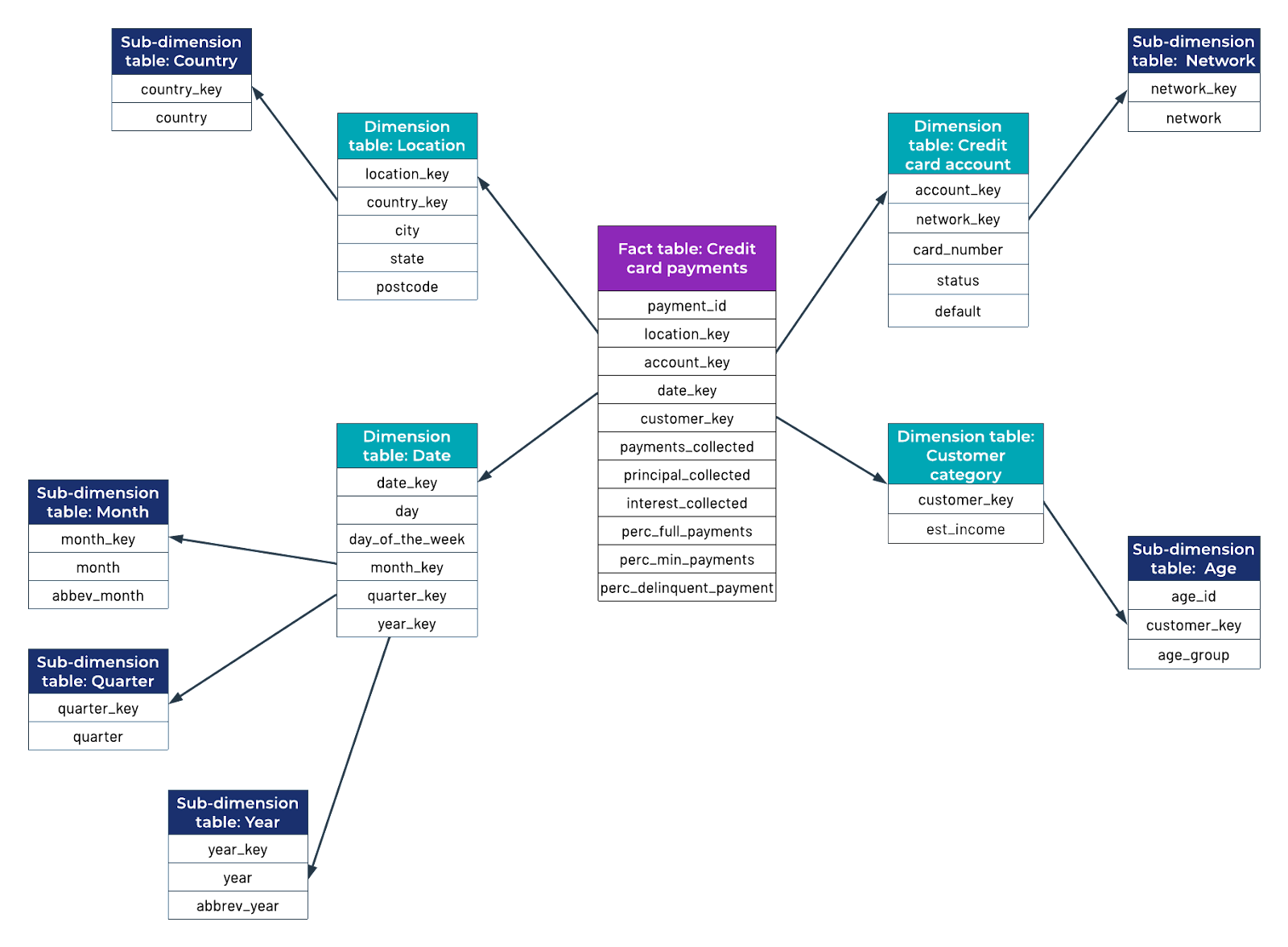Star Schema


Data warehouses use three kinds of schema to organize your data. A star schema is one of these three schema types. The other two are snowflake schema and galaxy schema. While there are differences between the three, they all share a similarity in that they all promote fast and efficient querying of large data sets.
These schema designs leverage fact and dimension tables. Fact tables contain aggregated measurements and metric data that summarize business data. In contrast, dimension tables have keys that link them to fact tables. Dimension tables exist to provide additional context around the facts. Fact tables contain the majority of the data in data warehouse schemas, so they occupy most of the storage space in the data warehouse.
The descriptions below outline how each of these schemas functions in practice and explore them with a simple example of credit card payments data from Burst Bank.
Star schema example
In the figure below, the credit card payments fact table is related to four dimensions:
- Location
- Date
- Credit card account
- Customer group.
The Customer group includes estimated income and age. The fact table also includes many aggregate measures of data credit card payment data. This includes the percentage of full payments collected and the percentage of minimum payments collected. Business analysts use these measures to answer the types of questions that will help their company make business decisions. For example, they might ask “Are customers over the age of 40 more likely than customers under 40 to make full payments?”

What is a Snowflake schema?
In a snowflake schema, each dimension connects to a central fact table. Some of the dimension tables are normalized so that they have sub-dimensions. This normalization reduces some of the data redundancy and makes it easier to maintain and store data. However, this comes at the cost of less efficient queries because each query requires more tables to be joined together.
Snowflake schema example
In the figure below, the credit card payments fact table is related to the same dimensions as in the star schema example. However, each dimension table is also connected to one or more sub-dimension tables. For example, the date dimension table has sub-dimensions for month, quarter, and year. The sub-dimension tables for month and year include abbreviations that business analysts might use to look up the month or year from the database.

What is a Galaxy schema?
Galaxy schema, also known as the fact constellation schema, has several fact tables. Each of these tables holds both the keys and aggregate data for specific parts of a business. Each fact table can connect to some of the same dimension tables. However, fact tables also connect to some dimension tables not connected to other fact tables. In this design, dimension tables cannot have sub-dimensions. This schema results in slower queries than both the star and snowflake schemas because its complexity means more tables must be joined when the data is queried. However, galaxy schemas can be useful for extremely complex data because they lower data redundancy by normalizing the data and mapping data to multiple fact tables.
Galaxy schema example
In the figure below, a fact table that contains aggregated data about the merchant at which customers made purchases has been added to Burst Bank’s data warehouse. The merchant fact table is connected to a dimension table that describes merchants by the category of goods or services they sell.

How Starburst helps with complex data warehouse setups
Starburst’s distributed query engine, based on open-source Trino is particularly beneficial in the following ways:
Distributed Query Processing: Distribute queries across multiple nodes enables it to handle large datasets and complex join operations typical in these schemas.
Connectors to Various Data Sources: Connect to a wide range of data sources(including: AWS S3, GCS, Azure data lake) which is particularly useful in environments where data is spread across different systems and formats, a common scenario in complex data warehousing setups.
Deploy in various environments: Including cloud platforms, on-premises systems, and hybrid setups. This flexibility is crucial for businesses with diverse data infrastructure, often seen with different warehousing schemas.
Scalability: As data volume grows, which is often the case in data warehousing, performance remains consistent, regardless of the complexity of the data schema in use.
 5 Challenges of data warehouses
5 Challenges of data warehouses GigaOm TCO report: Starburst data lakehouse enables 3x faster time to insight at half the cost
GigaOm TCO report: Starburst data lakehouse enables 3x faster time to insight at half the cost Can the data fabric automate the creation of data products?
Can the data fabric automate the creation of data products?